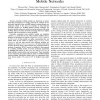Free Online Productivity Tools
i2Speak
i2Symbol
i2OCR
iTex2Img
iWeb2Print
iWeb2Shot
i2Type
iPdf2Split
iPdf2Merge
i2Bopomofo
i2Arabic
i2Style
i2Image
i2PDF
iLatex2Rtf
Sci2ools
103
click to vote
INFOCOM
2007
IEEE
2007
IEEE
Modeling Time-Variant User Mobility in Wireless Mobile Networks
Abstract— Realistic mobility models are important to understand the performance of routing protocols in wireless ad hoc networks, especially when mobility-assisted routing schemes are employed, which is the case, for example, in delay-tolerant networks (DTNs). In mobility-assisted routing, messages are stored in mobile nodes and carried across the network with nodal mobility. Hence, the delay involved in message delivery is tightly coupled with the properties of nodal mobility. Currently, commonly used mobility models are simplistic random i.i.d. model that do not reflect realistic mobility characteristics. In this paper we propose a novel time-variant community mobility model. In this model, we define communities that are visited often by the nodes to capture skewed location visiting preferences, and use time periods with different mobility parameters to create periodical re-appearance of nodes at the same location. We have clearly observed these two properties based on analysis o...
Related Content
| Added | 03 Jun 2010 |
| Updated | 03 Jun 2010 |
| Type | Conference |
| Year | 2007 |
| Where | INFOCOM |
| Authors | Wei-jen Hsu, Thrasyvoulos Spyropoulos, Konstantinos Psounis, Ahmed Helmy |
Comments (0)

